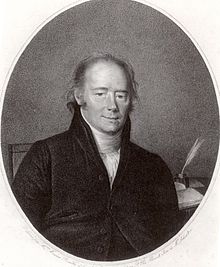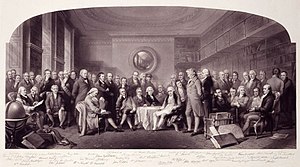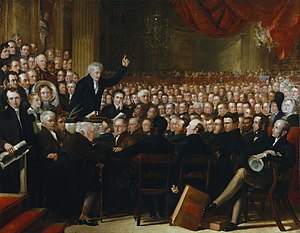William Allen (English Quaker)
William Allen | |
|---|---|
 | |
| Born | 29 August 1770 Spitalfields,London,[1]England |
| Died | 30 September 1843(aged 73) Stoke Newington,London, England |
| Movement | abolitionistQuakers |
William AllenFRSFLSFGS(29 August 1770 – 30 September 1843) was an English scientist andphilanthropistwhoopposed slaveryand engaged in schemes of social and penal improvement in early 19th-centuryEngland.
Early life
[edit]Allen was born in 1770, the eldest son in theQuakerfamily of Job Allen (1734–1800), asilk manufacturer,and his wife Margaret Stafford (died 1830). He was educated at a Quaker school inRochester, Kent,and then went into his father's business.[2]As a young man in the 1790s, he became interested in science. He attended meetings of scientific societies, including lectures atSt. Thomas's HospitalandGuy's Hospital,becoming a member of the Chemical Society of the latter establishment. On Job Allen's death, the family silk firm was taken over by his father's assistant.
Allen had concentrated on his own career in the field ofpharmacy,taking over the Plough Court chemical business of Joseph Gurney Bevan who retired in 1795.[2][3]In 1802, he was elected a Fellow of theLinnean Societyand lectured on chemistry at Guy's Hospital. A year later he was made president of the Physical Society at Guy's, and on the advice ofHumphry DavyandJohn Daltonalso accepted an invitation from theRoyal Institutionto become one of its lecturers.
In 1807, Allen's original research (on carbon) enabled him to be successfully proposed for election toFellowship of the Royal Society,bringing him into contact with those who were publishing much of the original scientific research of the day. This strengthened his ties with the eminent Humphry Davy, and in due course with his long-standing friendLuke Howard,who was likewise elected to Fellowship of the Royal Society, though some years later.
Pharmacist
[edit]
Allen was known in commerce for his pharmaceutical company at 2 Plough Court, trading in 1795 as Mildred & Allen while he was in partnership with Samuel Mildred. It was situated offLombard StreetinLondon.In 1797, Allen brought inLuke Howardas a partner. A later partner was Daniel Bell Hanbury, father of the botanistDaniel Hanbury.By 1856, the company had becomeAllen & Hanburys.[4][5][6]It was acquired in 1958 byGlaxo Laboratories,who retained the Allen & Hanburys name as a separate marque within the GSK group.
Allen strengthened the company's links with medical institutions, particularly Guy's Hospital, where he was elected to its Physical Society. Using Plough Court for meetings, he also co-founded theAskesian Society.There new ideas for research and experimentation could be discussed with others such asLuke Howard,Joseph Fox,William Hasledine Pepys,William Babington,and the surgeonAstley Cooper.A second laboratory was opened for the development of new chemicals, a few miles away inPlaistow.
In 1841,Jacob Bellpressed for a professional body for pharmacists.[7]Allen co-foundedThe Pharmaceutical Society,which later becameThe Royal Pharmaceutical Society.He was its first president.[8]

Abolitionist
[edit]As a teenager, under the influence ofQuakerabolitionists, Allen gave upsugaras a reaction to theAtlantic slave tradeand abstained from it until 1834. He became interested in the politics of abolitionism in 1790/1, and in 1792, made a speech on the topic at the Worshipful Company of Coachmaker's Hall. The speech was published as a pamphlet byMartha Gurney,which was influenced by writer William Fox.[11]In 1794, he befriendedThomas Clarkson.[2]
In 1805, after some years of assisting theSociety for the Abolition of the Slave Trade,William Allen was elected to its committee.

The group had always been strongly influenced by Quakers, and particularly by those based in or near London. All the members of its predecessor committee (1783–1787) had been Quakers, and nine of the twelve founders of the subsequent non-denominational Society for the Abolition of the Slave Trade were Quakers, including two –Samuel Hoare Jrand Joseph Woods Sr (father of the botanistJoseph Woods Jr) – who lived close to William Allen inStoke Newington,the village near London where Allen had family interests after his second marriage in 1806.
Perhaps the best known committee member of the new non-denominational abolition society, founded in 1787, wasWilliam Wilberforce,who, unlike its Quaker members, was eligible as anAnglicanto be elected to, and sit in, theHouse of Commons.Wilberforce visited William Allen at his experimental gardens on several occasions in his role as the Society's parliamentary representative. He had long been familiar with the village, owing to family connections. His sister Sarah had married the lawyerJames Stephens,whose family home was the Summerhouse, a large house adjoiningAbney Parkin the very grounds of the mansion that later, in the 1820s, was to become Allen's novel girls' school.
William Allen was also a founder member and a Director of theAfrican Institution,the successor body to theSierra Leone Company,sponsored by philanthropists to establish a colony inWest Africafor slaves freed on a voluntary basis, through the abolitionists' efforts, in America.[12]The work of the successor body began in 1808, when the colony had been handed to the Crown in return for the British Parliament passing legislation for its protection at about the same time as the passing in 1807 of theActfor the abolition of the slave trade.
Allen's active interest in the abolitionist cause continued until his death. In the mid-1830s he was passionate about abolition ofthe apprenticeship clause,and achieving the complete freedom of African-Caribbean people on 1 August 1838. His biographer,James Sherman,records, "the apprenticeship clause in the Bill... had been greatly abused by the planters. Mr Allen was indefatigable in his efforts, by interviews with Ministers and official persons.. His account of the spirit-stirring time is graphic:"
- The cruelty and oppression of the planters of Jamaica, as exercised on those poor sufferers, whose redemption from slavery we have paid twenty millions, has been exposed in the face of day. The West Indies in 1837, the result of personal investigation by our friendJoseph Sturge,has created a great sensation... The Anti Slavery Associations in all quarters are in a high degree of excitement, and petitions are loading the tables of both Houses of Parliament, begging for the abolition of the apprenticeship clause, and the complete establishment of freedom...on the 1st of Eight Month, 1838.
In 1838, the Friends sent a party to France. Allen went withElizabeth Fryand her husband,Lydia Irving,andJosiah Forster.They were there on other business but despite the language barrier Fry and Irving visited French prisons.[13]
In 1839, Allen became a founding Committee Member of the British and Foreign Anti-slavery Society for the Abolition of Slavery and the Slave-trade Throughout the World, which is today known asAnti-Slavery International.In this role he was an organiser of, and delegate to, theworld's first anti-slavery convention,which was held in London in 1840 – an event depicted in a large painting byBenjamin Haydonthat hangs in theNational Portrait Gallery,London.
Pacifist
[edit]Allen made an approving note in his diary, during 1798, on a pacifist tract,The Lawfulness of Defensive War upon Christian Principles Impartially Considered.It was by "A Clergyman of the Church of England", on the basis of a later publication thought to be J. Bradley Rhŷs, but not further identified.[14]> In 1811, with the support ofJames Mill,he started a publication entitledThe Philanthropist.It published articles by Mill and byJeremy Bentham.[15]At the end of theNapoleonic Wars,it printed peace petitions.[16]
In 1814, about a month afterNapoleonwas exiled toElba,a Peace Committee met at Allen's house in Plough Court. A leading activist who attended wasJoseph Tregelles Price.The idea of a "peace association" was in the air, supported by pseudonymous writers. One of those, certainly known to Allen, was the UnitarianWilliam Pitt Scargill,associated also withRichard PhillipsofThe Monthly Magazine.In 1816, Allen became a founding member of theSociety for the Promotion of Permanent and Universal Peace,after another meeting in his home.[17]By 1823, however, his earlier trust in theHoly Alliance,and in particularAlexander I of Russia,to uphold peace in Europe, had given way to disillusionment.[18]
Other philanthropic works and interests
[edit]Allen's philanthropic work was closely allied to his religious beliefs, and began at an early age. In 1814 he became a partner inNew Lanark.[2]In the area ofpenal reform,prompted byBasil Montagu,he founded a Society for the Diffusion of Knowledge Respecting the Punishment of Death and the Improvement of Prison Discipline, in 1808.[19]
Nutrition and self-sufficiency
[edit]In 1798 Allen set up a Soup Society inSpitalfields.[20]His later interest in agricultural experiments was also aimed improving the nutrition and diet of ordinary people. Using only small plots, he carried out trials at Lordship Lane inStoke Newington,and later put into practice some of his findings at the model agricultural settlement ofLindfieldthat he helped establish.
Allen'sself-sufficient settlementwas described in detail in his pamphletColonies at Home,where he stated "instead of encouraging emigration at enormous expense per head let the money be applied to the establishment of Colonies at Home and the increase of our national strength". At the time (1820s) the familiar colonies were inthe Americasso the whole area became known as "America". This identity remains in the local street names and people's memories of the cottages in what is now America Lane.[21]
Education
[edit]Allen was approached to help fund the ideas ofJoseph Lancasterand hismonitorial system,under which one teacher supervised several senior pupils, who in turn instructed many junior ones.[22]In 1808 Allen,Joseph FoxandSamuel Whitbreadco-founded the Society for Promoting the Lancasterian System for the Education of the Poor, from 1814 theBritish and Foreign School Society.In 1810 Allen became treasurer of the Society, whose aim was to open progressive schools in England and abroad.
In 1824 Allen founded theNewington Academy for Girls,also known as the Newington College for Girls, aQuaker school.The headmistress wasSusanna Corder.Quaker views on womenhad from the beginning tended towards equality, with women allowed to minister, but still, at the time,girls' educational opportunitieswere limited. His school offered a wide range of subjects "on a plan in degree differing from any hitherto adopted", according to the prospectus. Here Allen was able to ensure that the new sciences were covered (he taught astronomy, physics, and chemistry himself[23]), as well as many languages. Allen hiredUgo Foscolo,a revolutionary and poet, to teach Italian.[24]The school was situated at Fleetwood House and made much use ofAbney Park,the grounds in which it sat. It was also innovative in commissioning the world's firstschool bus,designed byGeorge Shillibeer,to transport the pupils toGracechurch Streetmeeting houseon Sundays. The school was the subject of a poem byJoseph Pease,a railway pioneer who later became the first Quaker MP.
Evangelism and travel
[edit]From 1818 to 1820 Allen toured Europe with the Quaker evangelistStephen Grellet.In 1818 they were inNorway.[25]After his third wife's death, Allen travelled extensively. In 1840, for example, he spent five months in Europe withElizabeth FryandSamuel Gurney.
Family life
[edit]
William Allen married Mary Hamilton in 1796. They had a daughter, who bore the same name. The motherdid not recover from the childbirth,anddied just two days later.
In 1806, Allen married for the second time. His new wife, Charlotte Hanbury was born in 1762. The couple visited the continent in 1816, but Charlotte died during their travels, leaving him to bring up his adolescent daughter Mary. In 1823, Mary, who married another Cornelius Hanbury, gave birth to a son, but she died nine days later.
William Allen married for the third time in 1827.Grizellwas the eldest sister of another family of well-off Stoke Newington Quakers, of whom the best-known isSamuel Hoare Jr(1751–1825), one of the twelve founding members of theSociety for the Abolition of the Slave Trade.She had been nurse and companion to her father, a merchant in the City of London, and then married Wilson Birkbeck in 1801. As a wealthy widow, she contributed to the 1824 foundation ofNewington Academy for Girls,and three years later she and William Allen, both co-founders of this novel educational establishment, married. She was 72, and the marriage was greeted by a satirical cartoon entitled "Sweet William & Grizzell-or- Newington nunnery in an uproar!!!" byRobert Cruikshank.[26]
Grizell Allen died in 1835.
Death and memorial
[edit]William Allen died on 30 December[27]1843 and was buried inStoke Newington,London, in the grounds of the Yoakley Road Quaker Meeting House. Today this has been replaced by aSeventh-Day Adventistchapel, the other half of its grounds becoming a small Council-maintained park for the nearby public housing estate.
Sources and further reading
[edit]- Sherman, Rev. James(1851).Memoir of William Allen, F.R.S.Charles Gilpin.
- Claus Bernet (2007). "William Allen (English Quaker)". In Bautz, Traugott (ed.).Biographisch-Bibliographisches Kirchenlexikon (BBKL)(in German). Vol. 28. Nordhausen: Bautz. cols. 20–24.ISBN978-3-88309-413-7.
- Margaret, Nicolle (2001).William Allen: Quaker Friend of Lindfield (1770–1843).Quakers. Nicolle, Margaret.ISBN978-0-9541301-0-7.
- Doncaster, Hugh (1965) 'Friends of Humanity: with special reference to the Quaker William Allen', London: Dr William's Trust
- Cripps, Ernest C. (1927).Plough Court: The Story of a Notable Pharmacy 1715-1927.Allen & Hanburys, London.
- Chapman-Huston, Desmond; Cripps, Ernest C. (1954).Through a City Archway: The Story of Allen and Hanburys 1715–1954.John Murray, London.ASINB0000CIZI9.
- Shirren, Adam John (1951).The Chronicles of Fleetwood House.A.J. Shirren, London.ASINB0000CI4TT.
References
[edit]- ^"William Allen".mdx.ac.uk. 2007. Archived fromthe originalon 6 October 2006.Retrieved21 July2007.
- ^abcdBartle, G. F. "Allen, William".Oxford Dictionary of National Biography(online ed.). Oxford University Press.doi:10.1093/ref:odnb/392.(Subscription orUK public library membershiprequired.)
- ^"Biographical Index--Dissenters, 1700-1860 - Timothy Whelan, Professor of English, Georgia Southern University".Google Search.Retrieved13 March2018.
- ^Bennion, Elisabeth (1979).Antique Medical Instruments.University of California Press. p. 305.ISBN9780520038325.Retrieved13 March2018.
- ^Richmond, Lesley; Stevenson, Julie (5 October 2017).The Pharmaceutical Industry: A Guide to Historical Records.Taylor & Francis. p. 229.ISBN9781351884297.Retrieved13 March2018.
- ^Hudson, Briony; Boylan, Maureen (8 June 2013).The School of Pharmacy, University of London: Medicines, Science and Society, 1842-2012.Academic Press. p. 25.ISBN9780124076907.Retrieved13 March2018.
- ^Burnby, Juanita. "Bell, Jacob".Oxford Dictionary of National Biography(online ed.). Oxford University Press.doi:10.1093/ref:odnb/2006.(Subscription orUK public library membershiprequired.)
- ^The Pharmaceutical, Journal (2007)."William Allen: Anti Slavery campaigner"(PDF).pharmaceutical-journal.com.
- ^Engraving after 'Men of Science Living in 1807-8',John Gilbertengraved by George Zobel andWilliam Walker,ref. NPG 1075a, National Portrait Gallery, London, accessed February 2010
- ^Smith, HM (May 1941)."Eminent men of science living in 1807-8".J. Chem. Educ.18(5): 203.doi:10.1021/ed018p203.
- ^Clapp, Elizabeth J.; Jeffrey, Julie Roy (21 April 2011).Women, Dissent and Anti-Slavery in Britain and America, 1790-1865.Oxford University Press. p. 62.ISBN9780199585489.Retrieved13 March2018.
- ^"William Allen".quakersintheworld.org.Retrieved13 December2017.
- ^Amanda Phillips, 'Irving, Lydia (1797–1893)’, Oxford Dictionary of National Biography, Oxford University Press, 2004accessed 20 June 2017
- ^Ceadel, Martin (1996).The Origins of War Prevention: The British Peace Movement and International Relations, 1730-1854.Clarendon Press. pp. 176–80.ISBN9780198226741.
- ^The New Werner Twentieth Century Edition of the Encyclopaedia Britannica: A Standard Work of Reference in Art, Literature, Science, History, Geography, Commerce, Biography, Discovery and Invention.Werner Company. 1907.
- ^Ceadel, Martin (1996).The Origins of War Prevention: The British Peace Movement and International Relations, 1730-1854.Clarendon Press. p. 206.ISBN9780198226741.
- ^van der Linden, Wilhelmus Hubertus (1987).The International Peace Movement, 1815–1874.Tilleul Publications. pp. 2–4.ISBN9789080013414.
- ^Brock, Peter (8 March 2015).Pacifism in Europe to 1914.Princeton University Press. p. 356.ISBN9781400867493.
- ^van der Linden, Wilhelmus Hubertus (1987).The International Peace Movement, 1815–1874.Tilleul Publications. p. 22.ISBN9789080013414.
- ^van der Linden, Wilhelmus Hubertus (1987).The International Peace Movement, 1815–1874.Tilleul Publications. p. 20.ISBN9789080013414.
- ^rediscoveringamerica.org.uk
- ^van der Linden, Wilhelmus Hubertus (1987).The International Peace Movement, 1815–1874.Tilleul Publications. p. 20.ISBN9789080013414.
- ^Shirren, Fleetwood House p.160, cited inQuaker history pageArchived30 September 2011 at theWayback Machine
- ^A P Baggs, Diane K Bolton and Patricia E C Croot, 'Stoke Newington: Education', in A History of the County of Middlesex: Volume 8, Islington and Stoke Newington Parishes, ed. T F T Baker and C R Elrington (London, 1985), pp. 217-223. British History Onlinehttp://www.british-history.ac.uk/vch/middx/vol8/pp217-223[accessed 28 March 2016].
- ^Blegen, Theodore Christian (1931).Norwegian Migration to America, 1825–1860.Ardent Media. p. 29.Retrieved13 March2018.
- ^British Museum collection
- ^Life of William Allen with Selections from his correspondence, volume II, page 540 published 1847
- 1770 births
- 1843 deaths
- English scientists
- People of the Industrial Revolution
- English educational theorists
- English abolitionists
- Fellows of the Royal Society
- Fellows of the Linnean Society of London
- English Quakers
- People from Stoke Newington
- English pharmacists
- English Christian pacifists
- Quaker abolitionists
- Committee members of the Society for the Diffusion of Useful Knowledge
- 18th-century industrialists
- 19th-century industrialists
- 19th-century British pharmacists
- 18th-century British pharmacists
